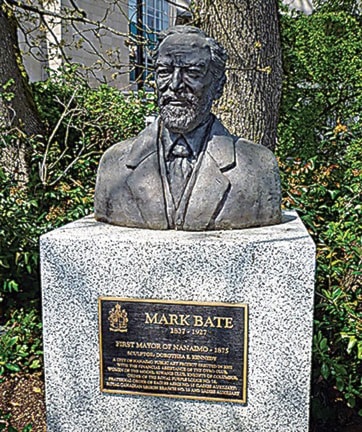He may not share top honours with St. Mark the evangelist but Mark Bate comes about as close to sainthood as mortals get — a man universally esteemed.
How respected was he? In May 1878, Nanaimo voters subscribed to the purchase of a gold watch and chain, a silver coffee and tea service, epergne and tray, and a testimonial of appreciation for "...Your startling worth as a gentleman, both in your business and private life as evinced by your sound judgment; far reaching sagacity; earnest industry; tenacity of purpose; integrity and firmness in action; and withal your imperturbable urbanity and courtesy in the performance of your duty in every walk and relation of your life."
Not quite an MP's pension but praise of the highest order and such as bestowed upon few public officers.
Elected as the Bastion City's first mayor in 1875 (when Nanaimo had all of 1,500 citizens), Bate served 16 terms—11 of them by acclamation—over a quarter of a century. Three times he retired, only to be persuaded to serve again. Surely his electoral record is unique in provincial history.
Bate could remember when 'Colvilletown' was just a "mining hamlet of some 45 buildings [and] the Indian camps;" when the "main part—nearly the whole—of Nanaimo was composed of the Bastion and a white-washed row of houses standing on a rising eminence a little way from the waterfront—the grassy slope between the buildings and the harbour looking as fresh as spring..."
Bate had a way with words, too, as evidenced by his speeches and published reminiscences of earlyday Nanaimo.
His introduction to Vancouver Island occurred on Jan. 18, 1857, with his arrival at Fort Victoria aboard the vessel Princess Royal. Late of Birmingham, Eng., he was 19 years old and, with his cousin and uncle, in the employe of the Hudson's Bay Co., who posted him to Nanaimo. There he served as clerk, accountant and chief cashier (originally under his uncle, George Robinson) until 1869 when his employers sold their coal mining operations to the Vancouver Coal Mining and Land Co. Bate was part of the deal, as manager, a post he held for 15 years.
He'd found time to marry Sarah Anne Cartwright of Worcestershire and begin a family of eight sons and daughters, be elected as mayor and the city's first justice of the peace. As well as first chairman of the Board of Education, Library Institute and Hospital Board committeeman, and government agent. Not to mention his memberships with the Masons, Oddfellows, Foresters, etc.
There was the suggestion of a senatorship, too, but that would have meant his having to leave Nanaimo so he declined.
He'd also tried his hand at publishing, having established with three friends (one of them up-and-coming coal baron Robert Dunsmuir) the Nanaimo Gazette, on Bastion Street. It failed in only six months, all partners losing their investments—a novel experience for Bate and Dunsmuir. Half a century after, Bate returned to journalism with a fascinating, well-written series of reminiscences in The Daily Herald. That newspaper is gone, too, but Bate's eloquent word-pictures of a young Nanaimo are, fortunately, a matter of record.
In 1925, Mark Bate was 90 years old. That year, City Hall honoured him with the unveiling of a commissioned portrait by artist George L. Southwell. In his acceptance speech Bate said he'd been lured to B.C. by his uncle's letters about the Fraser River gold rush. As it happened, the closest he came to mining was working in his office, later as manager of a coal mining company in "the City of Black Diamonds".
He highlighted some of the changes which had occurred over the past 71 years, all but licking his lips at his favourite memory: "And then the ham was real ham, so different from the kind...on the market today."
He died two years later while visiting family and friends in England. His body was returned to his adopted Nanaimo for a civic funeral and interment.
Thus it should come as no surprise—indeed, it's only fitting—that Nanaimo maps show Bate Point and Mark Bay, the southern tip and recess of Newcastle Island. Qualicum area has 3100-foot-high Mount Mark, overlooking Horne Lake, which was named for him by his friend and brother-in-law, HBC trader Adam Grant Horne.
